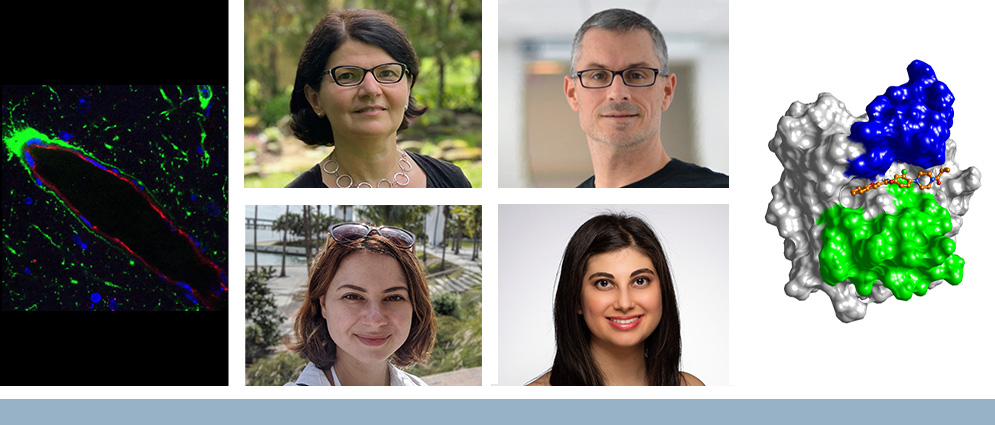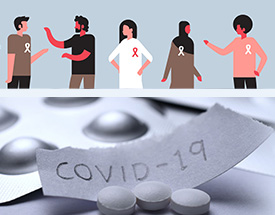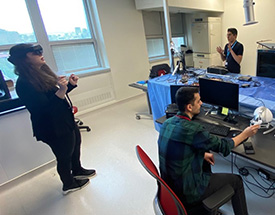- Home /
- About Us /
- Annual Reports /
- Annual Report 2022 /
- Year in review - Metabolic disorders and complications program - MeDiC

RI-MUHC ANNUAL REPORT 2022
YEAR IN REVIEW
METABOLIC DISORDERS AND COMPLICATIONS (MeDiC) PROGRAM
RESEARCH HIGHLIGHTS
How a hunger-suppressing hormone crosses the blood-brain barrier
A study led by Maia Kokoeva, PhD, provides an answer to the long-standing question of how the hunger-suppressing hormone leptin enters the brain to curb appetite despite the presence of the blood-brain barrier. The study showed that some of the specialized cells that enwrap brain blood vessels, the pericytes, have a key role in leptin brain access. “Our data suggests that leptin exits the blood vessel lumen via the junctions that connect the endothelial cells of the vessel wall,” explains first author and former RI-MUHC trainee, Liliia Butiaeva, PhD. (Cell Metabolism)
New G protein inhibitor identified, with potential for cancer therapies
A study led by Stéphane Laporte, PhD, may lead to the development of new classes of drugs for cancer therapies. The work uncovered a new inhibitor molecule, which acts in a unique way to target small G proteins involved in cancer. “Interestingly, because this molecule acts specifically on the two small G proteins Ras and Arf6, which control mitogenic responses and growth factor receptor internalization, it may confer increased therapeutic advantages in different types of cancer,” says Jenna Giubilaro, PhD, a former trainee in the Laporte lab and first author of the publication. (Nature Communications)

Type 1 diabetes: a combination therapy
Led by researchers from the MeDiC Program (RI MUHC) and Lunenfeld-Tanenbaum Research Institute in Toronto, Ontario, a study published in Nature Medicine describes an add-on treatment that could improve outcomes for people with type 1 diabetes. The results of a placebo-controlled multisite clinical trial showed that the addition of empagliflozin, a drug that promotes glucose excretion in the urine, to both closed-loop insulin delivery and standard pump therapy, improved blood glucose control for people living with type 1 diabetes. Ahmad Haidar, PhD, is first author of the study.

Selected MeDiC Program news links
- How does the hunger-suppressing hormone leptin cross the blood-brain barrier?
- New G protein inhibitor identified, with potential for cancer therapies
- Type 1 diabetes: a combination therapy improves glucose control and performance of artificial pancreases
- RI-MUHC team studies a novel, fully automated insulin delivery system
- Discovery of mechanics of drug targets for COVID-19
- RI-MUHC scientist part of McGill team delivering World Alzheimer Report 2021
- A Governor General’s Gold Medal, and more, for Anne-Julie Tessier
- MORE MeDiC Program news
SELECTED PUBLICATIONS
Olivia Auclair, Sergio A. Burgos. Carbon footprint of Canadian self-selected diets: Comparing intake of foods, nutrients, and diet quality between low- and high-greenhouse gas emission diets: Journal of Cleaner Production 316, 2021. doi: 10.1016/j.jclepro.2021.128245.
Vanessa Ferreira, Claire Lawson, Franco M. Carli, Celena Scheede-Bergdahl, Stéphanie Chevalier. Feasibility of a novel mixed-nutrient supplement in a multimodal prehabilitation intervention for lung cancer patients awaiting surgery: A randomized controlled pilot trial: International Journal of Surgery 93, 2021. doi: 10.1016/j.ijsu.2021.106079.
Joseph Mussa, Anne Sophie Brazeau, Tricia M. Peters, Mourad Dahhou, Claudia A. Sanmartin, Nancy A. Ross, Elham Rahme, Kaberi Dasgupta. Associations of overweight and gestational diabetes mellitus with free sugars from solid and liquid sources: cross-sectional and nested case-control analyses: BMC Public Health 21(1), 2021. doi: 10.1186/s12889-021-12000-3.
Lucie Canaff, Vito Guarnieri, Yoojung Kim, Betty Y.L. Wong, Alexis Nolin-Lapalme, David E.C. Cole, Salvatore Minisola, Cristina Eller-Vainicher, Filomena Cetani, Andrea Repaci, Daniela Turchetti, Sabrina Corbetta, Alfredo Scillitani, David Goltzman. Novel Glial Cells Missing-2 (GCM2) variants in parathyroid disorders: European Journal of Endocrinology 186(3): 351-366, 2022. doi: 10.1530/EJE-21-0433.
Suman Rao, Benoît Thibault, Lisa Peyrard, Anne Laure Larroque-Lombard, Martin Rupp, Cédric Thauvin, Bertrand Jean-Claude. Quantitative analysis of the potency of equimolar two-drug combinations and combi-molecules involving kinase inhibitors in vitro: The concept of balanced targeting: International Journal of Molecular Sciences 22(17), 2021. doi: 10.3390/ijms22179569.
Jiarong Li, Aimée Lee Luco, Anne Camirand, Rene St.-Arnaud, Richard Kremer. Vitamin D Regulates CXCL12/CXCR4 and Epithelial-To-Mesenchymal Transition in a Model of Breast Cancer Metastasis to Lung: Endocrinology 162(7), 2021. doi: 10.1210/endocr/bqab049.
Suzanne N. Morin, Lin Yan, Lisa M. Lix, William D. Leslie. Long-term risk of subsequent major osteoporotic fracture and hip fracture in men and women: a population-based observational study with a 25-year follow-up: Osteoporosis International 32(12): 2525-2532, 2021. doi: 10.1007/s00198-021-06028-9.
Shaifali Sandal, Jiyoon B. Ahn, Dorry L. Segev, Marcelo Cantarovich, Mara A. McAdams-DeMarco. Comparing outcomes of third and fourth kidney transplantation in older and younger patients: American Journal of Transplantation 21(12): 4023-4031, 2021. doi: 10.1111/ajt.16786.
Hossein Mohammadhassanzadeh, Karim Oualkacha, Wenmin Zhang, William Klement, Amelie Bourdiec, Jennat Lamsatfi, Yang Yi, Bethany J. Foster, Paul A. Keown, Howard M. Gebel, Frans H.J. Claas, Ruth Sapir-Pichhadze. On Path to Informing Hierarchy of Eplet Mismatches as Determinants of Kidney Transplant Loss: Kidney International Reports 6(6): 1567-1579, 2021. doi: 10.1016/j.ekir.2021.03.877.
Keisuke Omiya, Hiroaki Sato, Tamaki Sato, Linda J. Wykes, Mengyin Hong, Roupen Hatzakorzian, Arnold Scott Kristof, Thomas P.S. Schricker. Albumin and fibrinogen kinetics in sepsis: a prospective observational study: Critical Care 25(1), 2021. doi: 10.1186/s13054-021-03860-7.
Rémi Goupil, Mehdi Benlarbi, William Beaubien-Souligny, Annie Claire Nadeau-Fredette, Debashree Chatterjee, Guillaume Goyette, Lakshman Gunaratnam, Caroline Lamarche, Alexander Tom, Andres Finzi, Rita S. Suri. Short-term antibody response after one dose of BNT162b2 vaccine in patients receiving hemodialysis: CMAJ 193(22): E793-E800, 2021. doi: 10.1503/cmaj.210673.
Juliane Cruz Campos, Ziyun Wu, Paige D. Rudich, Sonja K. Soo, Meeta Mistry, Julio Cesar Batista Ferreira, T. Keith Blackwell, Jeremy M. Van Raamsdonk. Mild mitochondrial impairment enhances innate immunity and longevity through ATFS-1 and p38 signaling: EMBO Reports 22(12), 2021. doi: 10.15252/embr.202152964.
NEXT READ
PREVIOUS READ
BACK TO



